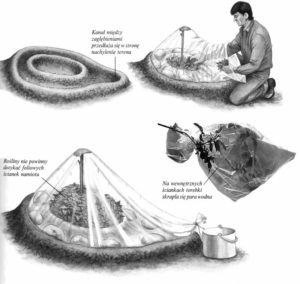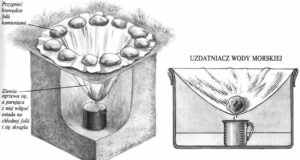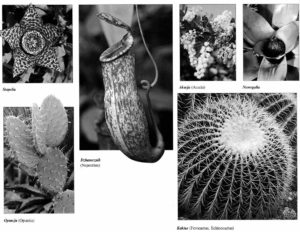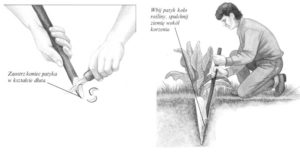 Rośliny parują przez liście. Para wodna z roślin noże być wykorzystana do pozyskiwania wody pitnej. Wystarczy otoczyć szczelnie roślinę.
Rośliny parują przez liście. Para wodna z roślin noże być wykorzystana do pozyskiwania wody pitnej. Wystarczy otoczyć szczelnie roślinę.
1 Na lekko pochyłym zboczu wykop koncentrycznie dwa zagłębienia w kształcie krateru, jedno większe, a drugie mniejsze. Zagłębienia powinien oddzielać wał ziemi.
2 Nad zagłębieniami rozłóż namiocik z plastikowego worka; wierzch unieś na maszcie z patyczka, a spód przygnieć kamieniami. Zagłębienie wyłóż zielonymi liśćmi i trawą.
3 Po usypaniu kopca z liści koniec worka mocno zawiąż, zwracając uwagę, by folia nie dotykała roślin. Kiedy liście zaczną się pocić, para wodna osiądzie na ściankach namiotu i się skropli, a potem spłynie do kanału między kraterami. Gdy w dolnej, przedłużonej części kanału zbierze się sporo wody, można ostrożnie poluzować sznurek na końcu worka i podstawić naczynie.
INNE SPOSOBY
W wyjątkowych sytuacjach można zbierać krople wody rozproszone we mgle unoszącej się nad podmokłymi terenami, układając płachtę materiału na ziemi lub rozpinając ją między drzewami. Inny sposób polega na rozciągnięciu na noc na trawie kawałka plastikowej folii. Gdy nocą powietrze ochłodzi się, para wodna pod nią zacznie się skraplać. Wprawdzie w ten sposób nie da się pozyskać większej ilości wody, ale chociaż na jakiś czas ugasi ona pragnienie.
Woda z gałązki
Na świeżą gałązkę z zielonymi liśćmi nałóż plastikową torebkę i zawiąż jej koniec. Para wodna wydzielana przez liście zacznie osadzać się od wewnątrz na ściankach torebki i skraplać.







